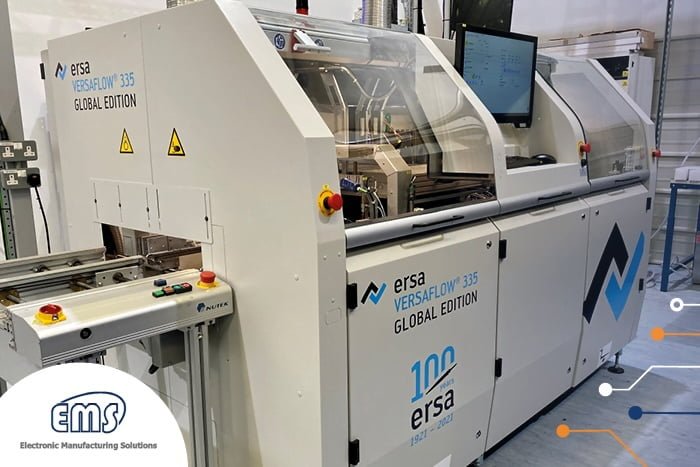Soldering, one of the key processes in the electronics manufacturing industry, allows electronic components to be electrically joined to printed circuit boards (PCBs).
With the growing popularity of surface-mount technology (SMT), through-hole technology is now less prevalent in PCB assembly. However, through-hole pins are still necessary for many boards and still need to be soldered. This process can either be done manually or with a selective soldering machine.
Does manual soldering still serve a purpose?
Manual soldering forms each joining individually by simultaneously applying a hot soldering iron and a wire made of solder to join the two surfaces. It’s most commonly used to assemble connectors onto cables and install jumper wires onto PCBs.
Whilst still useful for small-series production, manual soldering has outlived its role in mass production.
The risk of deviation will always be higher with manual soldering; if the temperature is too low, there’s no hole filling, and the different metals on the board won’t bond sufficiently with one another. If the temperature is too high, overheating can create consequences for the printed circuit board assembly (PCBA), and changes in temperature can lead to interruptions in the soldered connections. Manual soldering parts heat up rapidly, and within seconds, the temperature is well above the alloy’s melting temperature.
Furthermore, manual soldering is much less controlled than the SMT process, meaning it’s nearly impossible to reproduce the soldering process to the same standard, and the accuracy is never guaranteed. Though still useful for one-off solutions or repairing individual solder joints, selective soldering machines give PCB assemblers a more reliable and affordable tool for the job.
How does selective soldering work?
Selective soldering is an automated system that pumps molten solder up a reservoir through a nozzle to coat the leads extending out the bottom of a circuit board.
The system will move in multiple directions to apply solder on every lead the operators program it for. In addition, the selective soldering system can be programmed for the length of time and the temperature of the solder that’s being applied to get the best results. It’s an efficient tool that bridges the gap between manual soldering and wave soldering — a bulk soldering process involving a pan of molten solder.
Using a selective soldering machine is advantageous because it overcomes many of the common issues of manual soldering. For instance, when using a wider nozzle, these machines can solder two or three rows of connector pins in a single pass, substantially cutting down the amount of time needed for soldering. As well as this ability to quickly solder multiple areas, selective soldering machines also operate an infrared preheater to balance the uneven heating of thick copper boards — without this feature, it can be difficult to heat all of the thermally connected metal in the board sufficiently enough.
Comparative to manual soldering, selective soldering is also much more consistent; these machines will precisely solder only the necessary components without disturbing nearby SMT chip components. In turn, the inspection process for assembly operations can be reduced massively.
Introducing the Kurtz Ersa Versaflow
With all this in mind, it’s easy to see why we’re so excited to announce that the Kurtz Ersa Versaflow 3/35 Global Edition is now fully operational at EMS!
This new selective soldering machine offers enhanced flexibility with dual pots that are configured to run with different nozzle sizes and solder types. The machine also features a precise transport and clamping system, and we were impressed by how easy the Kurt Ersa is to program.
As a specialist PCBA manufacturer, we believe investing in state-of-the-art equipment is essential to ensuring the accuracy and quality of all the electronics products we manufacture. High-tech machinery allows us to refine each of our solutions to perfection, and the addition of selective soldering technology will boost our production capabilities.
We’ll also be accompanying the selective investment with a new nitrogen generator system from Atlas Copco. A consistent nitrogen supply is essential for selective soldering as it results in better wetting and clean joints with less flux and a lower temperature.
With these two new pieces of equipment working in unison, we’re ready to meet all demands — big or small!
We provide best-in-class electronics manufacturing services at EMS, using first-rate, specialist machinery. To find out more about our offering and how we can assist you, don’t hesitate to get in touch today.












